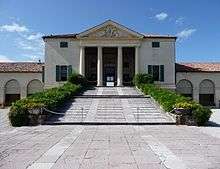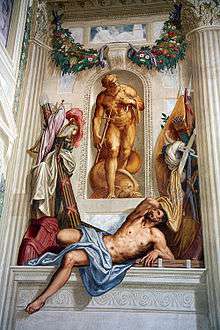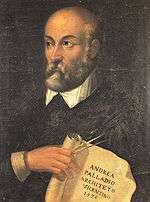Villa Emo

Villa Emo is a patrician villa in the Veneto, northern Italy, near the village of Fanzolo di Vedelago. It was designed by Andrea Palladio in 1559 for the Emo family of Venice and remained in the hands of the Emo family until it was sold in 2004. Since 1996, it has been conserved as part of the World Heritage Site "City of Vicenza and the Palladian Villas of the Veneto".
History
The building of Villa Emo was the culmination of a long-lasting project of the patrician Emo family of the Republic of Venice to develop its estates at Fanzolo. In 1509, which saw the defeat of Venice in the War of the League of Cambrai, the estate on which the villa was to be built was bought by Leonardo di Giovanni Emo from the Barbarigo family.[1] The landscape of Fanzolo has a continuous history since Roman times and it has been suggested that the layout of the villa reflects the straight lines of the Roman roads.[2]
The Emo family's central interest was at first in the cultivation of their newly acquired land. Not until two generations had passed did Leonardo di Alvise Emo commission Palladio to build a new villa in Fanzolo. We unfortunately do not have any firm dates for the commencement of the new building: the years 1555 or 1558 have been proposed. The date of completion is put at 1565; a document which attests to the marriage of Leonardo di Alvise with Cornelia Grimani has come down to us from that year.[3]
Architectural details

It is one of the most accomplished of the Palladian Villas, showing the benefit of 20 years of Palladio's experience in domestic architecture. It has been praised for the simple mathematical relationships expressed in its proportions, both of the elevation and the dimensions of the rooms. In 1570 Palladio published a plan of the villa in his treatise I Quattro Libri dell'Architettura. Unlike some of the other plans he included in this work, the one of Villa Emo corresponds nearly exactly to what was built.

The house is framed by two colonnaded wings which originally housed agricultural activities, for this was a working villa like Villa Badoer and a number of the other designs by Palladio. Andrea Palladio emphasises the usefulness of the lay-out in his treatise. He points out that the grain stores and work areas could be reached under cover, which was particularly important. Also, it was necessary for the Villa Emo's size to correspond to the returns obtained by good management. These returns must in fact have been considerable, for the side-wings of the building are unusually long, a visible symbol of prosperity. The Emo family introduced the cultivation of maize on their estate (and the plant, still new in Europe, is depicted in one of Zelotti's frescoes). In contrast to the traditional cultivation of millet, considerably higher returns could be obtained from the maize.[4]
It is not clear if the long walk, made of large square paving-stones, which leads to the front of the house, served a practical purpose. It seems to be a fifteenth-century threshing floor.[2] However, Palladio advised that threshing should not be carried out near a house.
The outer appearance of the Villa Emo is marked by a simple treatment of the entire body of the building, whose structure is determined by a geometrical rhythm. The living quarters are raised above ground-level, as are all of Palladio's other villas. Instead of the usual staircase going up to the main front door, the building has a wide ramp with a gentle slope. A wide flight of steps leads up to the loggia which takes the form of a column portico crowned by a gable - a temple front which Palladio applied to secular buildings. As in the case with the Villa Badoer, the loggia does not stand out from the core of the building as an entrance hall, but is retracted into it. The emphasis of simplicity extends to the column order of the loggia, for which Palladio chose the extremely plain Tuscan order.[5]

Frescoes
The exterior is simple, bare of any decoration. In contrast, the interior is richly decorated with frescoes by Giovanni Battista Zelotti, who also worked on Villa Foscari and other Palladian villas.
The main series of frescoes in the villa is grouped in an area with scenes featuring Venus, the goddess of love. Zelotti appears to have begun work on the frescoes in 1565. In the Great Room, the events in the frescoes concentrate on humanistic ideals, exemplary scenes such as Virtue portrayed in a scene from the life of Scipio Africanus. The Abstinence of Scipio appears frequently in cycles of frescoes for Venetian villas. For example, the Villa la Porto Colleoni in Thiene and Villa Cordellina in Montecchio Maggiore, built nearly 200 years later, also use this image, fostering ideals which, had in the 15th and 16th centuries, resulted from the renewed discussion of the depravity of town life, in contrast to the tranquility, abundance, and freedom of artistic thought associated with rural existence. Hence, another room in the villa is called the Room of the Arts, featuring frescoes with allegories of individual arts, such as astronomy, poetry or music.[6]
Media interest


In the 1990s Villa Emo was featured in Guide to Historic Homes: In Search of Palladio,[7] Bob Vila's three-part six-hour production for A&E Network.
The 2002 movie Ripley's Game used the Villa Emo as a location.[8]
See also
Notes
- ↑ Wundram (1993), p. 164
- 1 2 Andrea Palladio Centre Archived June 10, 2008, at the Wayback Machine. (English) (Italian) Centro Internazionale di Studi di Architettura Andrea Palladio, accessed September 2008
- ↑ Wundram (1993), p. 165
- ↑ Wundram (1993), p. 169
- ↑ Wundram (1993), p. 164
- ↑ Wundram (1993), p. 173
- ↑ BobVila.com. "Bob Vila's Guide to Historic Homes: In Search of Palladio".
- ↑ "Ripley's Game News" Archived June 9, 2008, at the Wayback Machine. Retrieved on 2008 05 31
References
- Boucher, Bruce (1998) [1994]. Andrea Palladio: The Architect in his Time (revised ed.). New York: Abbeville Press.
- Rybczynski, Witold (2002). 'The Perfect House: A Journey with Renaissance Master Andrea Palladio. New York: Scribner.
- Wundram, Manfred (1993). Andrea Palladio 1508-1580, Architect between the Renaissance and Baroque. Cologne: Taschen. ISBN 3-8228-0271-9.
External links
| Wikimedia Commons has media related to Villa Emo. |
- Villa Emo - official site
Coordinates: 45°42′42.2″N 11°59′28.4″E / 45.711722°N 11.991222°E
